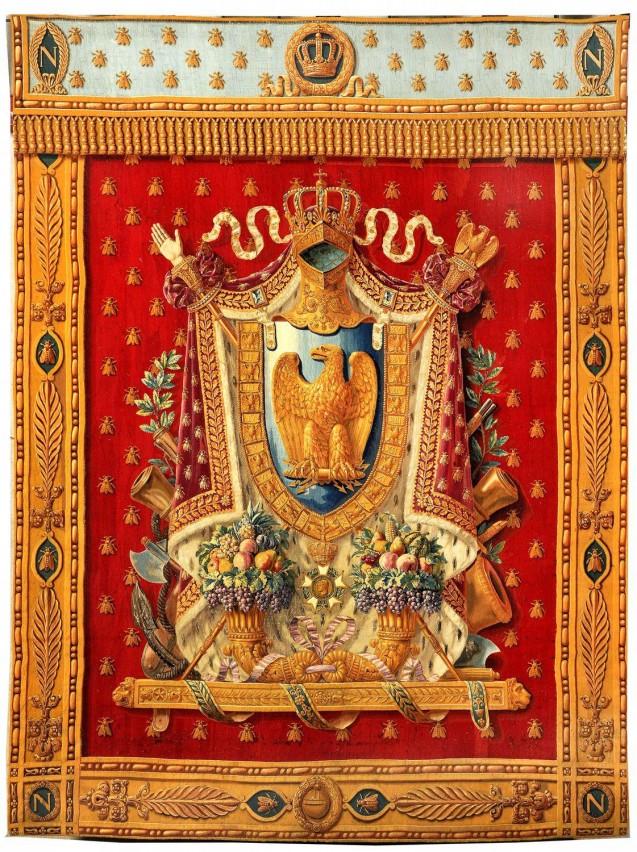This tapestry is a condensed version of the imperial symbols. The heraldic shield bearing the arms of the Empire, perfectly matching the description laid down by the decree of 10 July 1804: “of azure, with a gold eagle in the antique style, clutching a thunderbolt likewise gold”, is set against an imaginative background: the escutcheon itself is surrounded by the great necklace of the Légion d’Honneur (made up of sixteen gold eagles symbolising the sixteen cohorts of the Légion) and bears a helmet topped with an imperial crown. The escutcheon is set upon a purple mantle strewn with golden bees and bordered with a frieze of gold laurels and lined with ermine fur. The imperial sceptre and the “hand of justice” are placed in saltire behind the shield. Two horns of plenty, laden with fruit, are placed at the foot of the composition, superimposed upon a trophy of arms and cannons. The whole composition is set against a poppy-red ground dotted with golden bees. The border is decorated with palms alternating with bees and an “N” in each corner. The ensemble is reminiscent of the decoration designed by Percier and Fontaine for the canopy of the throne in the Throne Room, the space which preceded the Grand Cabinet.
In this abundance of symbols, we can identify the two main stylistic inspirations for that of the Napoleonic regime: namely, the neo-antique on the one hand, and the neo-monarchic on the other. From Greco-Roman antiquity come eagles, palms, trophies and horns of plenty. And from the former French monarchy we have the crown, the helmet, the sceptre, the hand of justice, the heraldic mantle, and even the bees, which are straight out of the famous “treasure of Childéric”. Over time, Napoleon sought ever more to be closely linked to the symbols linked to the latter. On 11 November 1812, in the middle of the retreat from Russia, he announced to Cambacérès from Smolensk his plan to organise a “solemn and religious” ceremony at the Church of the Invalides where a speech would be given “with the purpose of re-establishing in all its purity this fundamental maxim of the monarchy: “In France the king does not die”.
Thierry Sarmant, director of collections at the Mobilier National [French National Furniture Repository](translation RY)
This exceptional piece which survived not only the destruction of the Gobelins but also outlived the Palace for which it was created, namely the Tuileries, was exhibited at the Napoleon I’s Lost Palaces exhibtion (15 September 2021 – 15 February 2022) at the Mobilier National [French National Furniture Repository], partner of the 2021 Année Napoléon label.


